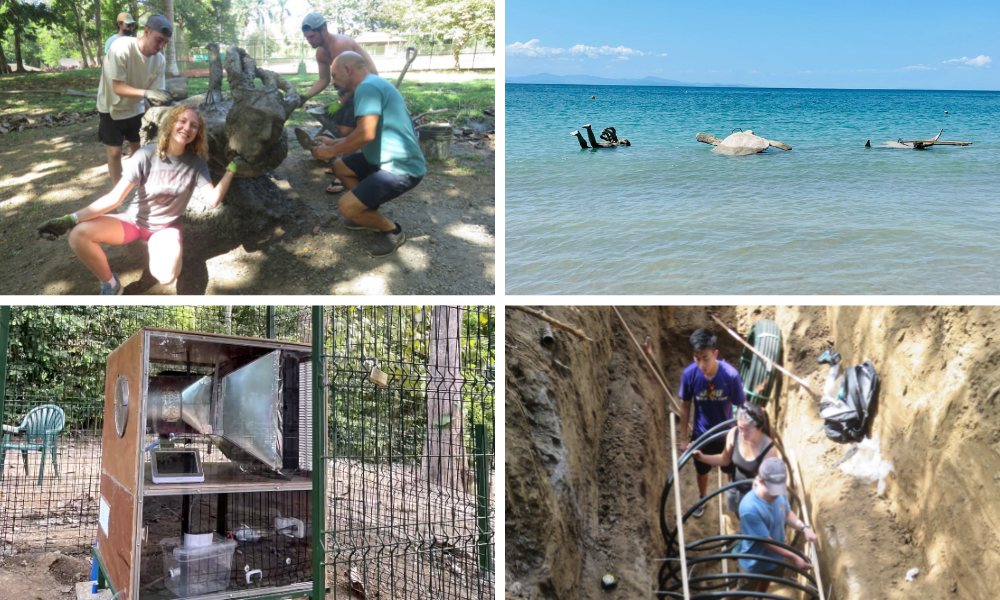ISAT students implement capstone projects in Costa Rica
Science and Technology
SUMMARY: A team of JMU Integrated Science and Technology (ISAT) students travel to Costa Rica and implement two capstone projects in 21 days.
By Meghan Long, CISE student writer
What could you accomplish in 21 days?
If you ask a team of JMU Integrated Science and Technology (ISAT) seniors if they could travel to Costa Rica and implement two capstone projects in 21 days over Winter Break - the answer would be a resounding yes.
Despite facing many challenges — two canceled trips, stringent travel guidelines due to COVID, and less than a month to get the job done — students packed their flip-flops and materials and headed to Hotel Punta Leona.
Maria Liu, Nicholas Long, and Brian Tang focused on the Water Out of Thin Air (WOTA) project. They designed a low-energy system that produces water from the atmosphere to address the problem of water scarcity.
Brian designed a system that was easy to build, inexpensive to produce, and met all the necessary criteria. Nicholas designed and built a monitoring system that could measure the system's temperature, humidity, water collection, and flow rate using multiple sensors and control devices. "Being able to translate what I study in the classroom into hands-on work was so rewarding," says Tang. Watch the video.
His experience was an eye-opener to the kind of work he hopes to do in the field. "There were so many things that I learned that I would not have gotten from the classroom alone," Tang explains. "I learned the importance of good communication, collaboration, as well as the challenge of managing a project. When it came to implementing our design, especially in another country, understanding how the country operates and adapting to the culture was a learning experience."
Ethan Leming, Evan Mason, Connor O’Brien, and Annie Williams worked on the Coral Reef Restoration project. The idea to work on a Coral Reef Restoration project is one Williams proposed herself—having a passion for the issue and the desire to make a change. "Knowing about this program and the feasibility to work on a project like this was in arm's reach," Williams explains. "I had no idea how the project would turn out or what we exactly would do. However, after getting our group together and doing the research, the project finally started to gain some momentum," she says. See the pictures
Williams and her teammates were able to collaborate with Hotel Punta Leona and an organization called MareBlue in Costa Rica to create four artistic structures to place underwater. The project helps to enhance the growth of the coral reef while simultaneously incorporating aesthetic elements to add interest to the design. The project is marketed as an "Underwater Museum," which Annie says has also helped the hotel promote business.
Though Williams acknowledges there were challenges in completing the work, she is grateful to have contributed something useful and meaningful to the area. "We really felt the gravity of what we were able to accomplish together," she explains. Along with a turtle and a Garabito Indian—a nod to Costa Rica—one of the structures the group designed was a JMU-themed design—now permanently sitting in the Underwater Museum for hundreds of visitors to admire.
ISAT professor and project advisor, Karim Altaii, explains the group's passion for sustainability. "For us, it was all about asking how we can make people's lives better without doing damage," Altaii explains.
"We have been working with the Hotel Punta Leona since 2010." says Altaii who has been advising capstone projects in Costa Rica for many years. "It is a beautiful working relationship. There is trust, faith, and, most importantly, a willingness to continue working together towards sustainability," he says.
Altaii is impressed with his students' drive and rigor. "It is serious work. Not only was the on-the-ground work completed by the students impressive, but so was the extensive planning the group did beforehand. We're dealing with a real customer, and we needed to deliver what we promised—and that's exactly what they did," he says.
Both Altaii and the students stress the camaraderie and reliance they had on each other as a group. It was one of the most amazing life experiences," says Williams. "The experience working with students made it all worthwhile," explains Altaii. Tang adds, "I do not believe this project would have been successful if we didn't lean on each other to get it done."
"I hope other JMU students will see and be inspired by the work completed by the two teams," says Altaii. "Great ideas come when you talk and reach out to people, travel, and you start to look at things around you in a new way. If you get out and pursue your passions, great things can happen."
Learn more about the ISAT major.
